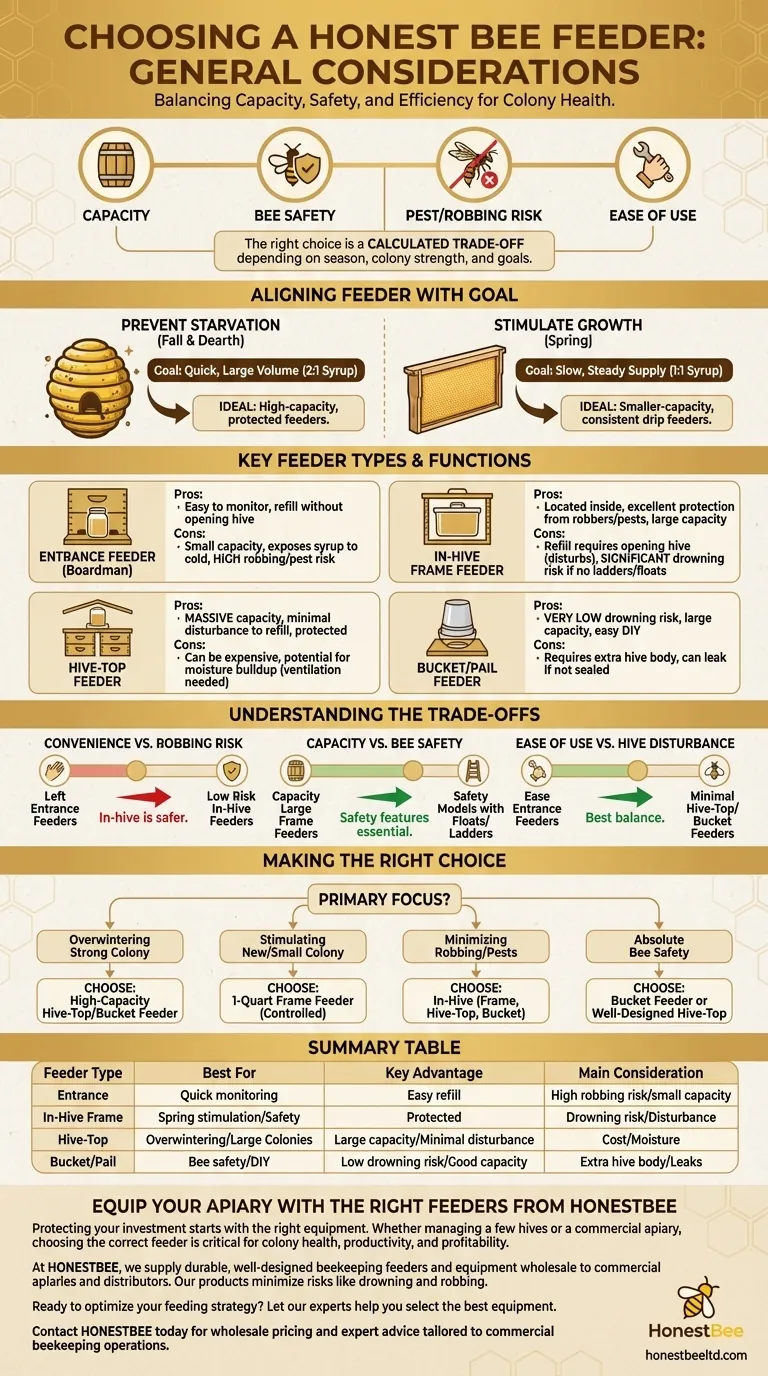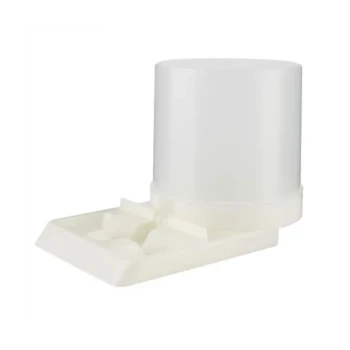When choosing a honey bee feeder, the primary considerations are its capacity, how it impacts bee safety, its potential to attract pests or robbers from other hives, and its ease of use for the beekeeper. No single feeder is perfect, so the right choice depends entirely on the season, the strength of your colony, and your specific beekeeping goals.
The most effective feeder isn't the most expensive or complex one; it's the one that best matches your colony's specific need while minimizing risks. Your decision is a calculated trade-off between providing food efficiently and protecting your bees from drowning, pests, and robbing.

Why We Feed Bees: Aligning Your Feeder with Your Goal
A feeder is a tool used to solve a specific problem. Before choosing one, you must first clarify your objective. Are you trying to save a colony from starvation or stimulate its growth? The answer dictates your choice.
Preventing Starvation (Fall & Dearth)
During late fall or a summer nectar dearth, the goal is to deliver a large volume of food quickly and efficiently. This requires a feeder that minimizes disturbance to the hive and holds a significant amount of heavy syrup (a 2:1 sugar-to-water ratio).
High-capacity feeders that are protected from outside bees are ideal for this purpose.
Stimulating Growth (Spring)
In early spring, the goal is to simulate a natural nectar flow to encourage the queen to lay eggs and expand the brood nest. This requires a slow, steady supply of light syrup (a 1:1 sugar-to-water ratio).
Smaller-capacity feeders work well here, as they provide a consistent "drip" of resources that mimics the start of the season.
Key Feeder Types and Their Functions
Each feeder style offers a distinct set of advantages and disadvantages. Understanding them is crucial for making an informed decision.
Entrance Feeders (Boardman Feeders)
These small feeders sit at the entrance of the hive, typically using an inverted jar. They are very common in beginner kits.
Pros: Easy to monitor syrup levels and refill without opening the hive. Cons: Small capacity, exposes the syrup to cold weather, and, most importantly, can incite robbing from other hives and attract pests.
In-Hive Frame Feeders
These are thin, rectangular containers designed to take the place of one or two frames inside the hive body.
Pros: Located inside the hive, offering excellent protection from robbers and pests. They can also have a large capacity. Cons: Refilling requires opening the hive, which disturbs the colony. More importantly, many designs pose a significant drowning risk to bees if they don't include ladders, floats, or textured inner walls.
Hive-Top Feeders
These feeders are placed on top of the uppermost hive body, directly under the outer cover. They offer the largest capacity and are designed with bee safety in mind.
Pros: Massive capacity (often several gallons), minimal disturbance to refill, and completely protected from robbers. Cons: Can be the most expensive option. If not properly ventilated, they can increase moisture levels inside the hive, which is especially problematic during winter.
Bucket or Pail Feeders
This is a simple, effective method where you place a bucket of syrup with small holes in the lid upside-down over the inner cover's central hole. An empty hive body is placed around it for protection.
Pros: Very low drowning risk, large capacity, and easy to construct or purchase. Cons: Requires an extra hive body to enclose the feeder, and leaks can occur if the lid is not sealed perfectly.
Understanding the Trade-offs
Choosing a feeder is an exercise in balancing competing priorities. What is convenient for you may not always be what is safest for your bees.
Convenience vs. Robbing Risk
Entrance feeders are the most convenient for the beekeeper but are by far the riskiest for the bees. Their placement at the front door is an open invitation for robber bees and wasps, which can weaken or destroy a colony. In-hive feeders are always a safer choice.
Capacity vs. Bee Safety
Large-capacity frame feeders are efficient but can become death traps. Always choose models with built-in safety features like floats or plastic mesh ladders that allow bees to climb out if they fall in. Never leave a frame feeder with smooth, slick sides in a hive.
Ease of Use vs. Hive Disturbance
While entrance feeders are easy to use, their limited utility makes them a poor primary choice. Hive-top and bucket feeders offer the best of both worlds: they are easy to refill without disturbing the bees in the brood nest below and are protected from outsiders.
Making the Right Choice for Your Colony
Your decision should be guided by a clear assessment of your goals and your colony's current state.
- If your primary focus is overwintering a strong colony: Choose a high-capacity hive-top or bucket feeder to provide a large volume of 2:1 syrup with minimal disturbance.
- If your primary focus is stimulating a new package or small hive in spring: A 1-quart frame feeder provides a controlled supply of 1:1 syrup safely inside the hive.
- If your primary focus is minimizing robbing and pest pressure: Avoid entrance feeders entirely and exclusively use in-hive options like frame, hive-top, or bucket feeders.
- If your primary focus is absolute bee safety: Choose a bucket feeder or a hive-top feeder with well-designed access points that prevent bees from accessing the main reservoir and drowning.
Ultimately, investing in a quality feeder that protects your bees from drowning and robbing is a direct investment in the health and survival of your colony.
Summary Table:
| Feeder Type | Best For | Key Advantage | Main Consideration |
|---|---|---|---|
| Entrance Feeder | Quick, easy monitoring | Easy to refill | High robbing risk; small capacity |
| In-Hive Frame Feeder | Spring stimulation; safety | Protected from robbers | Drowning risk; disturbs hive to refill |
| Hive-Top Feeder | Overwintering; large colonies | Large capacity; minimal disturbance | Cost; potential for moisture buildup |
| Bucket/Pail Feeder | Bee safety; DIY solutions | Low drowning risk; good capacity | Requires extra hive body; can leak |
Equip Your Apiary with the Right Feeders from HONESTBEE
Protecting your investment starts with the right equipment. Whether you manage a few hives or a large commercial apiary, choosing the correct feeder is critical for colony health, productivity, and profitability.
At HONESTBEE, we supply durable, well-designed beekeeping feeders and equipment wholesale to commercial apiaries and distributors. Our products are built to minimize risks like drowning and robbing, helping you maintain strong, thriving colonies.
Ready to optimize your feeding strategy? Let our experts help you select the best equipment for your specific needs.
Contact HONESTBEE today for wholesale pricing and expert advice tailored to commercial beekeeping operations.
Visual Guide

Related Products
- HONESTBEE Professional Hive Top Bee Feeder Feeding Solution
- HONESTBEE Entrance Bee Feeder Professional Hive Nutrition Solution for Beekeeping
- Professional Hive Top Bee Feeder for Beekeeping
- Professional Hive Front Entrance Bee Feeder
- In-Hive Dual Compartment Frame Bee Feeder for Targeted Colony Nutrition
People Also Ask
- What safety features are included in top feeders? A Guide to Drowning Prevention and Hive Safety
- What are the advantages of hive top feeders? Maximize Feeding Efficiency for Your Apiary
- How is the plywood floor fitted into the hive-top feeder? Ensure Longevity with a Floating Floor Design
- What should be done with feeders and equipment after feeding bees? Essential Steps for Apiary Health
- How do I keep bees from drowning in my top feeder? Ensure Safe Feeding for Your Hive



















